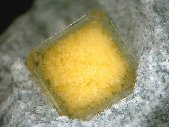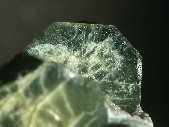[(Na,K)(Y,Ca)Si1638 · 10H
Narsarsukite is relatively common at MSH, where one can find some of the finest and largest specimens for the species. It occurs in the quarries and in outcrops of weathered hornfels on the north flank of the mountain.
PHYSICAL CHARACTERISTICS:
Color varies from pale to dark yellow, greenish yellow, dark green,
grayish brown to dark brown; colorless, pale pink, lemon-yellow to
orange-yellow.
Luster is vitreous to dull or greasy; vitreous to adamantine on the
tabular crystals.
Diaphaneity is transparent to translucent.
Crystal System is tetragonal; 4/
Crystal Habits include well formed, sharp, tabular or lath-shaped
crystals forming attractive radiating sprays, parallel stacked groups
and aggregates.
Cleavage {010} is perfect, {001} is very good and {100} is fair.
Fracture uneven to subconchoidal.
Hardness ranges from 6 to 7
Specific Gravity is approximately 2.75g/cm
Streak is white.
Associated Minerals include aegirine, albite, amphibole group,
calcite, carletonite, leucosphenite, lorenzenite, microcline, natrolite
and quartz.
Distinguishing Features: Crystal habit and color.
Origin: Named in 1990 for its locality, Narsarsuk, Greenland.
CLASSIFICATION:
Dana System
# 70.1.2.1
Strunz Classification
# VIII/F.34-10
REFERENCES:
MinRec 21:324 (1990), CanMin 8:506-514 (1966), Dana 8:1398-1399 (1997)
DISTRIBUTION AND RARITY AT MONT SAINT-HILAIRE:
MSH
¤¤¤

Narsarsukite crystals
© Jason B. Smith

Narsarsukite crystals
© Elmar Lackner
